BLDG3015: Project Delivery Systems and Contract Type Report
VerifiedAdded on 2023/06/03
|19
|4915
|493
Report
AI Summary
This report provides a detailed analysis of project delivery systems and contract types for a construction project. It begins with an executive summary outlining the key findings and recommendations. The report explores various project delivery system options, including traditional design-bid-build, design-build, construction management, multi-prime, and integrated project delivery. It recommends construction management as the most suitable procurement method, highlighting its suitability for complex projects, and the organizational structure involved. The report details the strengths and weaknesses of construction management, along with strategies for mitigating weaknesses. It also covers strategies to ensure successful project delivery, discusses other procurement methods, and recommends the GMP contract type. Further, the report addresses authority structure, trust-building, and the impact of non-Australian national status on procurement and contract choices. The report concludes with a summary and a section explaining the recommendations to a boss.
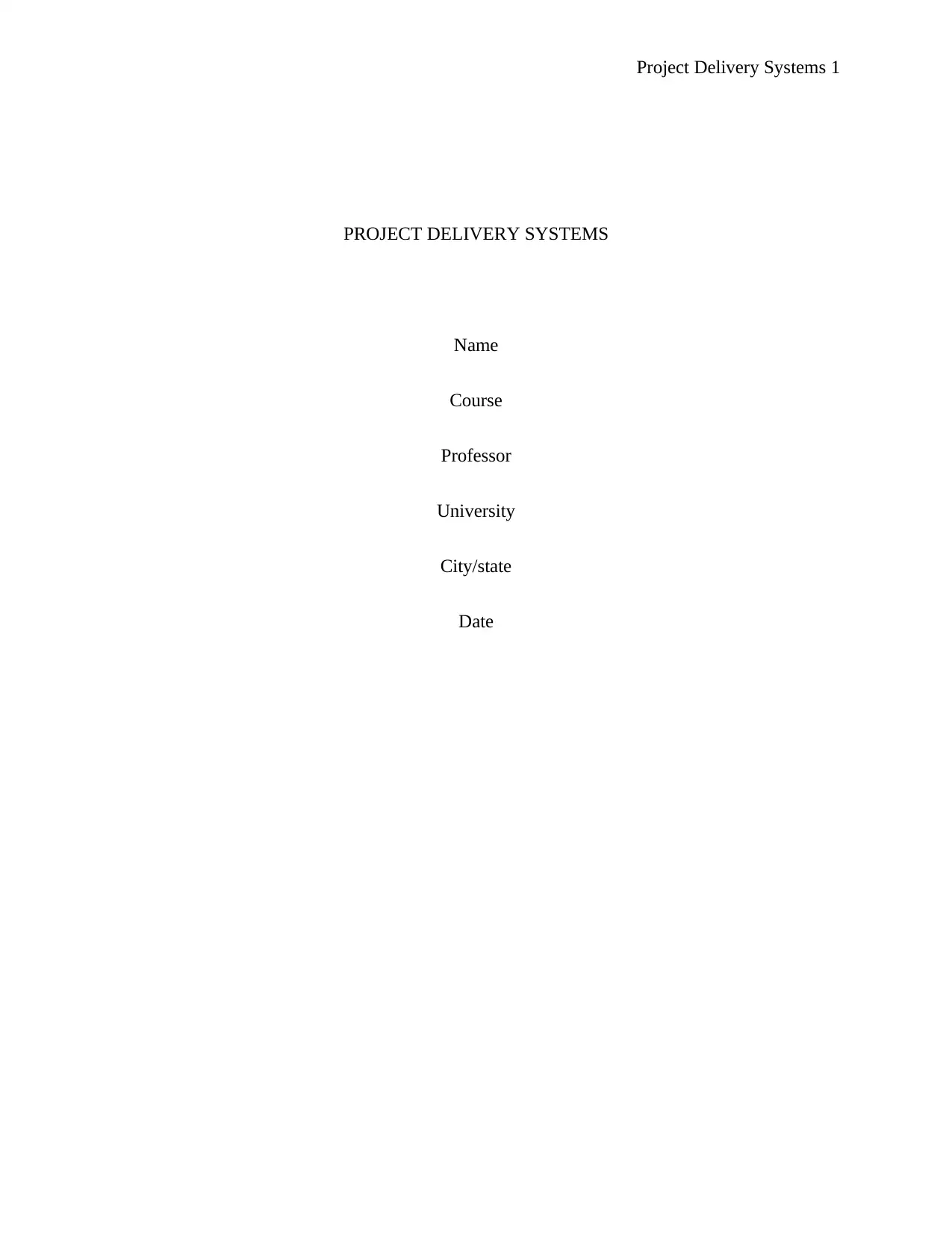
Project Delivery Systems 1
PROJECT DELIVERY SYSTEMS
Name
Course
Professor
University
City/state
Date
PROJECT DELIVERY SYSTEMS
Name
Course
Professor
University
City/state
Date
Paraphrase This Document
Need a fresh take? Get an instant paraphrase of this document with our AI Paraphraser

Project Delivery Systems 2
Executive Summary
This report presents an analysis of the suitable project delivery system and contract type for the
construction project in the case study. The project can only be delivered successfully if the right
project delivery system and contract type are used. Based on the client requirements and
experience, the most suitable project delivery system is construction management. The system
will enable the client to select a qualified construction manager to coordinate and oversee all
design and construction activities thus transferring most of the risks to the construction manager.
This system will make it possible to complete the project within stipulated time and budget. The
recommended contract type for the project is GMP. In this contract, a maximum price will be set
to protect the client against budget overrun and also give the construction manager and trade
subcontractors the opportunity to use cost saving strategies so as to benefit from higher profit
margins.
Executive Summary
This report presents an analysis of the suitable project delivery system and contract type for the
construction project in the case study. The project can only be delivered successfully if the right
project delivery system and contract type are used. Based on the client requirements and
experience, the most suitable project delivery system is construction management. The system
will enable the client to select a qualified construction manager to coordinate and oversee all
design and construction activities thus transferring most of the risks to the construction manager.
This system will make it possible to complete the project within stipulated time and budget. The
recommended contract type for the project is GMP. In this contract, a maximum price will be set
to protect the client against budget overrun and also give the construction manager and trade
subcontractors the opportunity to use cost saving strategies so as to benefit from higher profit
margins.
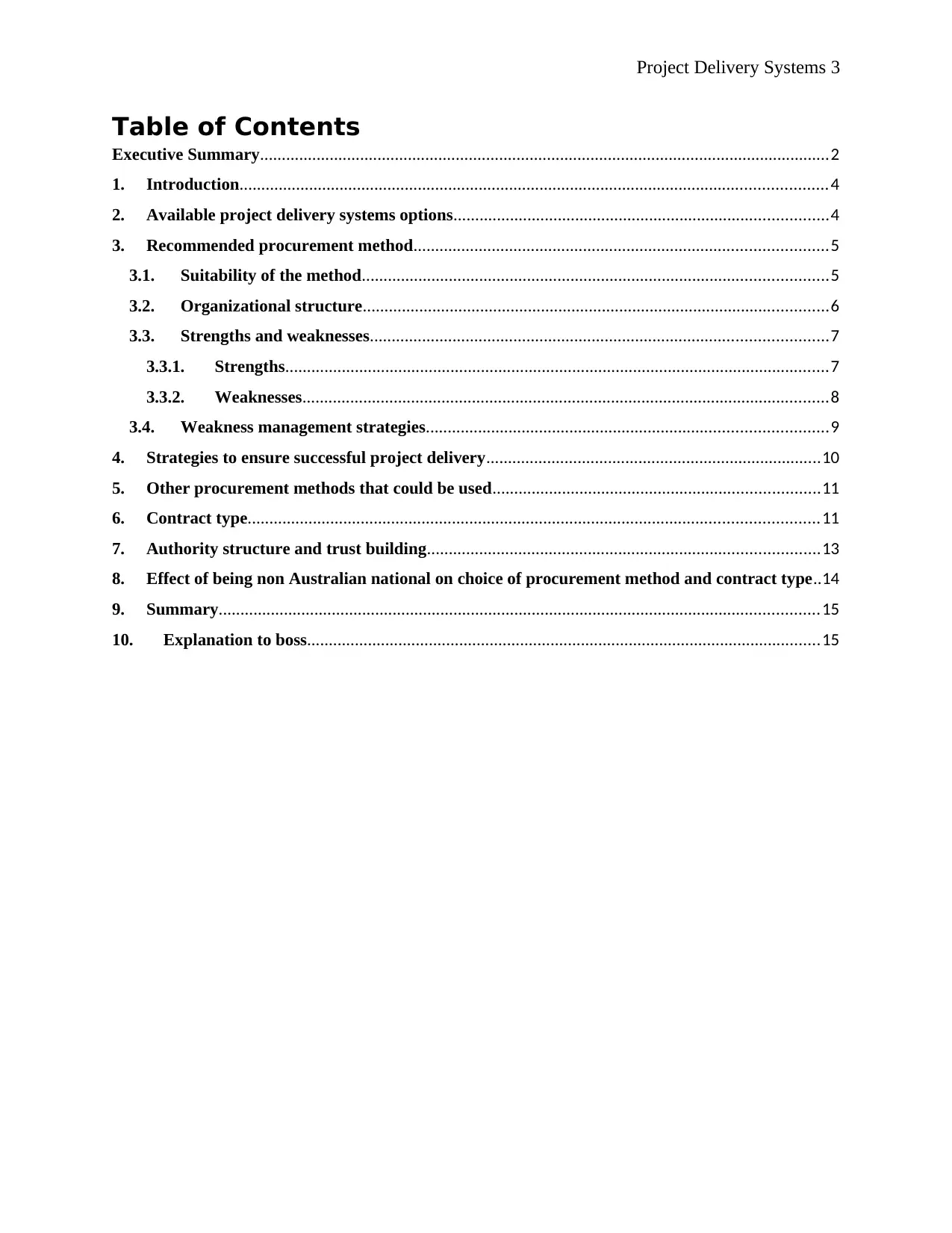
Project Delivery Systems 3
Table of Contents
Executive Summary...................................................................................................................................2
1. Introduction.......................................................................................................................................4
2. Available project delivery systems options......................................................................................4
3. Recommended procurement method...............................................................................................5
3.1. Suitability of the method...........................................................................................................5
3.2. Organizational structure...........................................................................................................6
3.3. Strengths and weaknesses.........................................................................................................7
3.3.1. Strengths.............................................................................................................................7
3.3.2. Weaknesses.........................................................................................................................8
3.4. Weakness management strategies............................................................................................9
4. Strategies to ensure successful project delivery.............................................................................10
5. Other procurement methods that could be used...........................................................................11
6. Contract type...................................................................................................................................11
7. Authority structure and trust building..........................................................................................13
8. Effect of being non Australian national on choice of procurement method and contract type..14
9. Summary..........................................................................................................................................15
10. Explanation to boss......................................................................................................................15
Table of Contents
Executive Summary...................................................................................................................................2
1. Introduction.......................................................................................................................................4
2. Available project delivery systems options......................................................................................4
3. Recommended procurement method...............................................................................................5
3.1. Suitability of the method...........................................................................................................5
3.2. Organizational structure...........................................................................................................6
3.3. Strengths and weaknesses.........................................................................................................7
3.3.1. Strengths.............................................................................................................................7
3.3.2. Weaknesses.........................................................................................................................8
3.4. Weakness management strategies............................................................................................9
4. Strategies to ensure successful project delivery.............................................................................10
5. Other procurement methods that could be used...........................................................................11
6. Contract type...................................................................................................................................11
7. Authority structure and trust building..........................................................................................13
8. Effect of being non Australian national on choice of procurement method and contract type..14
9. Summary..........................................................................................................................................15
10. Explanation to boss......................................................................................................................15
⊘ This is a preview!⊘
Do you want full access?
Subscribe today to unlock all pages.

Trusted by 1+ million students worldwide
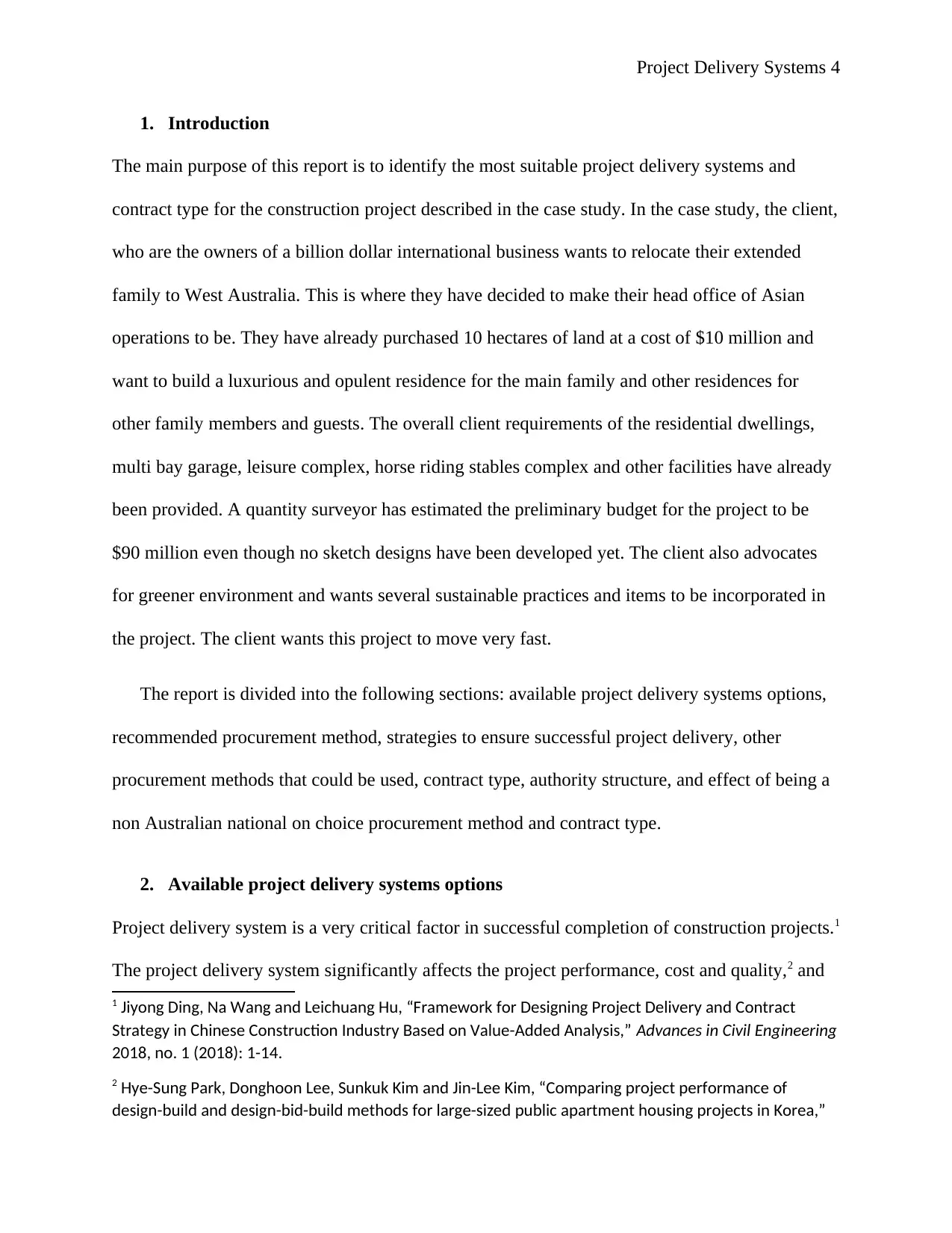
Project Delivery Systems 4
1. Introduction
The main purpose of this report is to identify the most suitable project delivery systems and
contract type for the construction project described in the case study. In the case study, the client,
who are the owners of a billion dollar international business wants to relocate their extended
family to West Australia. This is where they have decided to make their head office of Asian
operations to be. They have already purchased 10 hectares of land at a cost of $10 million and
want to build a luxurious and opulent residence for the main family and other residences for
other family members and guests. The overall client requirements of the residential dwellings,
multi bay garage, leisure complex, horse riding stables complex and other facilities have already
been provided. A quantity surveyor has estimated the preliminary budget for the project to be
$90 million even though no sketch designs have been developed yet. The client also advocates
for greener environment and wants several sustainable practices and items to be incorporated in
the project. The client wants this project to move very fast.
The report is divided into the following sections: available project delivery systems options,
recommended procurement method, strategies to ensure successful project delivery, other
procurement methods that could be used, contract type, authority structure, and effect of being a
non Australian national on choice procurement method and contract type.
2. Available project delivery systems options
Project delivery system is a very critical factor in successful completion of construction projects.1
The project delivery system significantly affects the project performance, cost and quality,2 and
1 Jiyong Ding, Na Wang and Leichuang Hu, “Framework for Designing Project Delivery and Contract
Strategy in Chinese Construction Industry Based on Value-Added Analysis,” Advances in Civil Engineering
2018, no. 1 (2018): 1-14.
2 Hye-Sung Park, Donghoon Lee, Sunkuk Kim and Jin-Lee Kim, “Comparing project performance of
design-build and design-bid-build methods for large-sized public apartment housing projects in Korea,”
1. Introduction
The main purpose of this report is to identify the most suitable project delivery systems and
contract type for the construction project described in the case study. In the case study, the client,
who are the owners of a billion dollar international business wants to relocate their extended
family to West Australia. This is where they have decided to make their head office of Asian
operations to be. They have already purchased 10 hectares of land at a cost of $10 million and
want to build a luxurious and opulent residence for the main family and other residences for
other family members and guests. The overall client requirements of the residential dwellings,
multi bay garage, leisure complex, horse riding stables complex and other facilities have already
been provided. A quantity surveyor has estimated the preliminary budget for the project to be
$90 million even though no sketch designs have been developed yet. The client also advocates
for greener environment and wants several sustainable practices and items to be incorporated in
the project. The client wants this project to move very fast.
The report is divided into the following sections: available project delivery systems options,
recommended procurement method, strategies to ensure successful project delivery, other
procurement methods that could be used, contract type, authority structure, and effect of being a
non Australian national on choice procurement method and contract type.
2. Available project delivery systems options
Project delivery system is a very critical factor in successful completion of construction projects.1
The project delivery system significantly affects the project performance, cost and quality,2 and
1 Jiyong Ding, Na Wang and Leichuang Hu, “Framework for Designing Project Delivery and Contract
Strategy in Chinese Construction Industry Based on Value-Added Analysis,” Advances in Civil Engineering
2018, no. 1 (2018): 1-14.
2 Hye-Sung Park, Donghoon Lee, Sunkuk Kim and Jin-Lee Kim, “Comparing project performance of
design-build and design-bid-build methods for large-sized public apartment housing projects in Korea,”
Paraphrase This Document
Need a fresh take? Get an instant paraphrase of this document with our AI Paraphraser
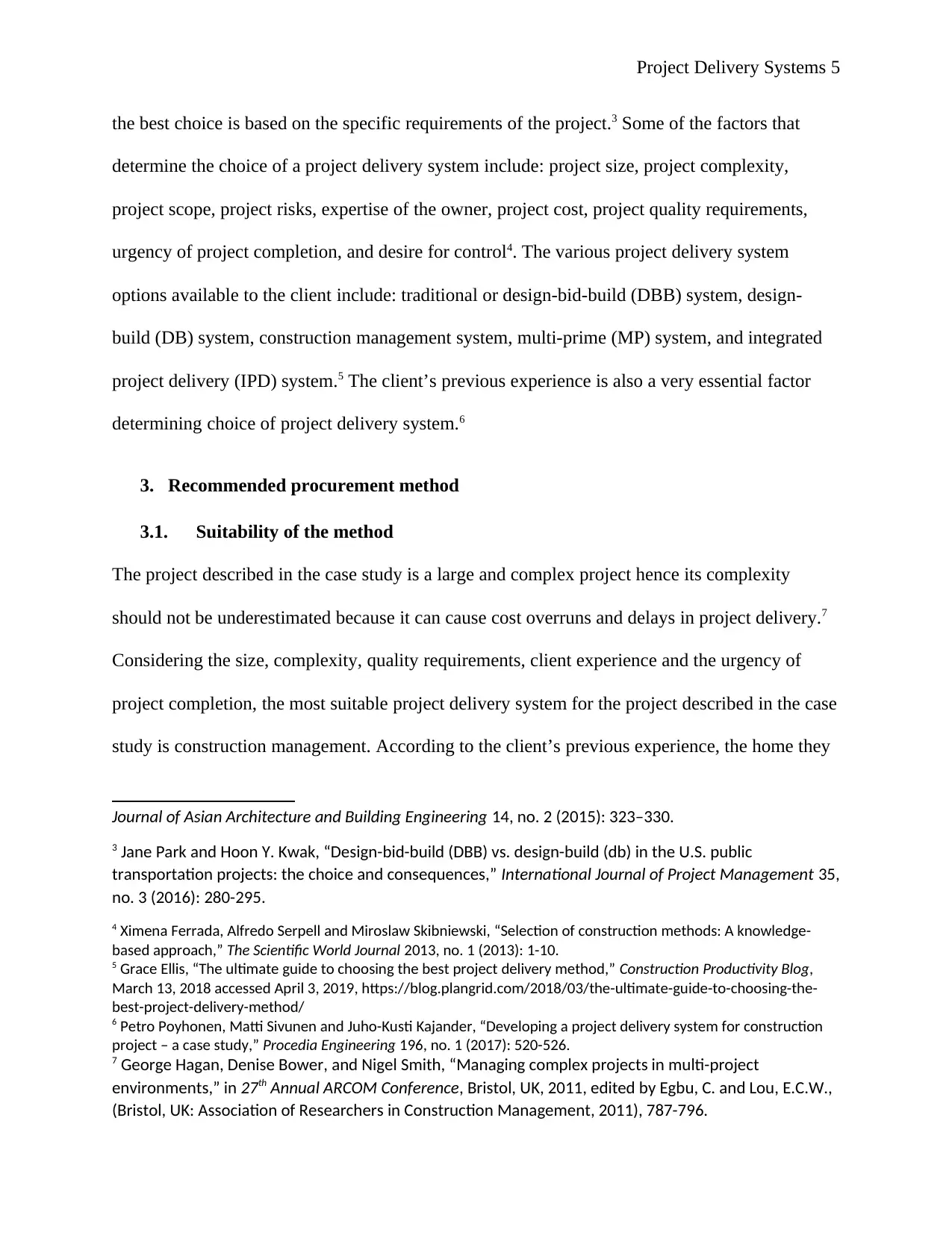
Project Delivery Systems 5
the best choice is based on the specific requirements of the project.3 Some of the factors that
determine the choice of a project delivery system include: project size, project complexity,
project scope, project risks, expertise of the owner, project cost, project quality requirements,
urgency of project completion, and desire for control4. The various project delivery system
options available to the client include: traditional or design-bid-build (DBB) system, design-
build (DB) system, construction management system, multi-prime (MP) system, and integrated
project delivery (IPD) system.5 The client’s previous experience is also a very essential factor
determining choice of project delivery system.6
3. Recommended procurement method
3.1. Suitability of the method
The project described in the case study is a large and complex project hence its complexity
should not be underestimated because it can cause cost overruns and delays in project delivery.7
Considering the size, complexity, quality requirements, client experience and the urgency of
project completion, the most suitable project delivery system for the project described in the case
study is construction management. According to the client’s previous experience, the home they
Journal of Asian Architecture and Building Engineering 14, no. 2 (2015): 323–330.
3 Jane Park and Hoon Y. Kwak, “Design-bid-build (DBB) vs. design-build (db) in the U.S. public
transportation projects: the choice and consequences,” International Journal of Project Management 35,
no. 3 (2016): 280-295.
4 Ximena Ferrada, Alfredo Serpell and Miroslaw Skibniewski, “Selection of construction methods: A knowledge-
based approach,” The Scientific World Journal 2013, no. 1 (2013): 1-10.
5 Grace Ellis, “The ultimate guide to choosing the best project delivery method,” Construction Productivity Blog,
March 13, 2018 accessed April 3, 2019, https://blog.plangrid.com/2018/03/the-ultimate-guide-to-choosing-the-
best-project-delivery-method/
6 Petro Poyhonen, Matti Sivunen and Juho-Kusti Kajander, “Developing a project delivery system for construction
project – a case study,” Procedia Engineering 196, no. 1 (2017): 520-526.
7 George Hagan, Denise Bower, and Nigel Smith, “Managing complex projects in multi-project
environments,” in 27th Annual ARCOM Conference, Bristol, UK, 2011, edited by Egbu, C. and Lou, E.C.W.,
(Bristol, UK: Association of Researchers in Construction Management, 2011), 787-796.
the best choice is based on the specific requirements of the project.3 Some of the factors that
determine the choice of a project delivery system include: project size, project complexity,
project scope, project risks, expertise of the owner, project cost, project quality requirements,
urgency of project completion, and desire for control4. The various project delivery system
options available to the client include: traditional or design-bid-build (DBB) system, design-
build (DB) system, construction management system, multi-prime (MP) system, and integrated
project delivery (IPD) system.5 The client’s previous experience is also a very essential factor
determining choice of project delivery system.6
3. Recommended procurement method
3.1. Suitability of the method
The project described in the case study is a large and complex project hence its complexity
should not be underestimated because it can cause cost overruns and delays in project delivery.7
Considering the size, complexity, quality requirements, client experience and the urgency of
project completion, the most suitable project delivery system for the project described in the case
study is construction management. According to the client’s previous experience, the home they
Journal of Asian Architecture and Building Engineering 14, no. 2 (2015): 323–330.
3 Jane Park and Hoon Y. Kwak, “Design-bid-build (DBB) vs. design-build (db) in the U.S. public
transportation projects: the choice and consequences,” International Journal of Project Management 35,
no. 3 (2016): 280-295.
4 Ximena Ferrada, Alfredo Serpell and Miroslaw Skibniewski, “Selection of construction methods: A knowledge-
based approach,” The Scientific World Journal 2013, no. 1 (2013): 1-10.
5 Grace Ellis, “The ultimate guide to choosing the best project delivery method,” Construction Productivity Blog,
March 13, 2018 accessed April 3, 2019, https://blog.plangrid.com/2018/03/the-ultimate-guide-to-choosing-the-
best-project-delivery-method/
6 Petro Poyhonen, Matti Sivunen and Juho-Kusti Kajander, “Developing a project delivery system for construction
project – a case study,” Procedia Engineering 196, no. 1 (2017): 520-526.
7 George Hagan, Denise Bower, and Nigel Smith, “Managing complex projects in multi-project
environments,” in 27th Annual ARCOM Conference, Bristol, UK, 2011, edited by Egbu, C. and Lou, E.C.W.,
(Bristol, UK: Association of Researchers in Construction Management, 2011), 787-796.

Project Delivery Systems 6
built in the USA exceeded the estimated cost by 20% hence he would not wish to have the same
experience. Getting an experienced construction manager is one of the strategies the client can
use to avoid budget overrun. Construction management is a procurement method where the client
hires a qualified construction manager to oversee the entire project, including the design,
scheduling, bidding, construction and cost control processes, and advice the owner accordingly.
This procurement method is most suitable for large, complex projects that require a good
deal of coordination and oversight, and where the owner of the project does not have a formal in-
house construction team. A construction manager helps the client to control cost and quality, and
avoid delays in complex projects. The client in this project can use his strong business networks
in Australia to appoint the most qualified, dedicated and trustworthy construction manager.
Therefore this procurement method is suitable because it suits the unique requirements of the
project and it will enable the client to complete the project within stipulated time and budget, and
to the required quality standards.
3.2. Organizational structure
In construction management method, the owner of the project makes contracts with two
parties only – the design team (comprising of architect, engineers and consultants) and a
construction manager. The owner appoints the design team and construction manager, and
involves them from the earliest stages of the project.8 This means that the construction manager
provides his perspective and input to the owner during the design stage9. The design team
develops the design of the project collaborating with the construction manager who is
responsible for building the project. The construction manager procures and manages specialist
8 John Skwiot, “Construction project delivery methods,” Archtoolbox, July 30, 2014 accessed April 3, 2019,
https://www.archtoolbox.com/project-management/project-planning/construction-project-delivery-methods.html
9 Jaime Partners, “Choosing project delivery method,” Jaime Partners, November 29, 2016 accessed April 3, 2019,
https://jaimepartners.com/choosing-a-project-delivery-method/
built in the USA exceeded the estimated cost by 20% hence he would not wish to have the same
experience. Getting an experienced construction manager is one of the strategies the client can
use to avoid budget overrun. Construction management is a procurement method where the client
hires a qualified construction manager to oversee the entire project, including the design,
scheduling, bidding, construction and cost control processes, and advice the owner accordingly.
This procurement method is most suitable for large, complex projects that require a good
deal of coordination and oversight, and where the owner of the project does not have a formal in-
house construction team. A construction manager helps the client to control cost and quality, and
avoid delays in complex projects. The client in this project can use his strong business networks
in Australia to appoint the most qualified, dedicated and trustworthy construction manager.
Therefore this procurement method is suitable because it suits the unique requirements of the
project and it will enable the client to complete the project within stipulated time and budget, and
to the required quality standards.
3.2. Organizational structure
In construction management method, the owner of the project makes contracts with two
parties only – the design team (comprising of architect, engineers and consultants) and a
construction manager. The owner appoints the design team and construction manager, and
involves them from the earliest stages of the project.8 This means that the construction manager
provides his perspective and input to the owner during the design stage9. The design team
develops the design of the project collaborating with the construction manager who is
responsible for building the project. The construction manager procures and manages specialist
8 John Skwiot, “Construction project delivery methods,” Archtoolbox, July 30, 2014 accessed April 3, 2019,
https://www.archtoolbox.com/project-management/project-planning/construction-project-delivery-methods.html
9 Jaime Partners, “Choosing project delivery method,” Jaime Partners, November 29, 2016 accessed April 3, 2019,
https://jaimepartners.com/choosing-a-project-delivery-method/
⊘ This is a preview!⊘
Do you want full access?
Subscribe today to unlock all pages.

Trusted by 1+ million students worldwide
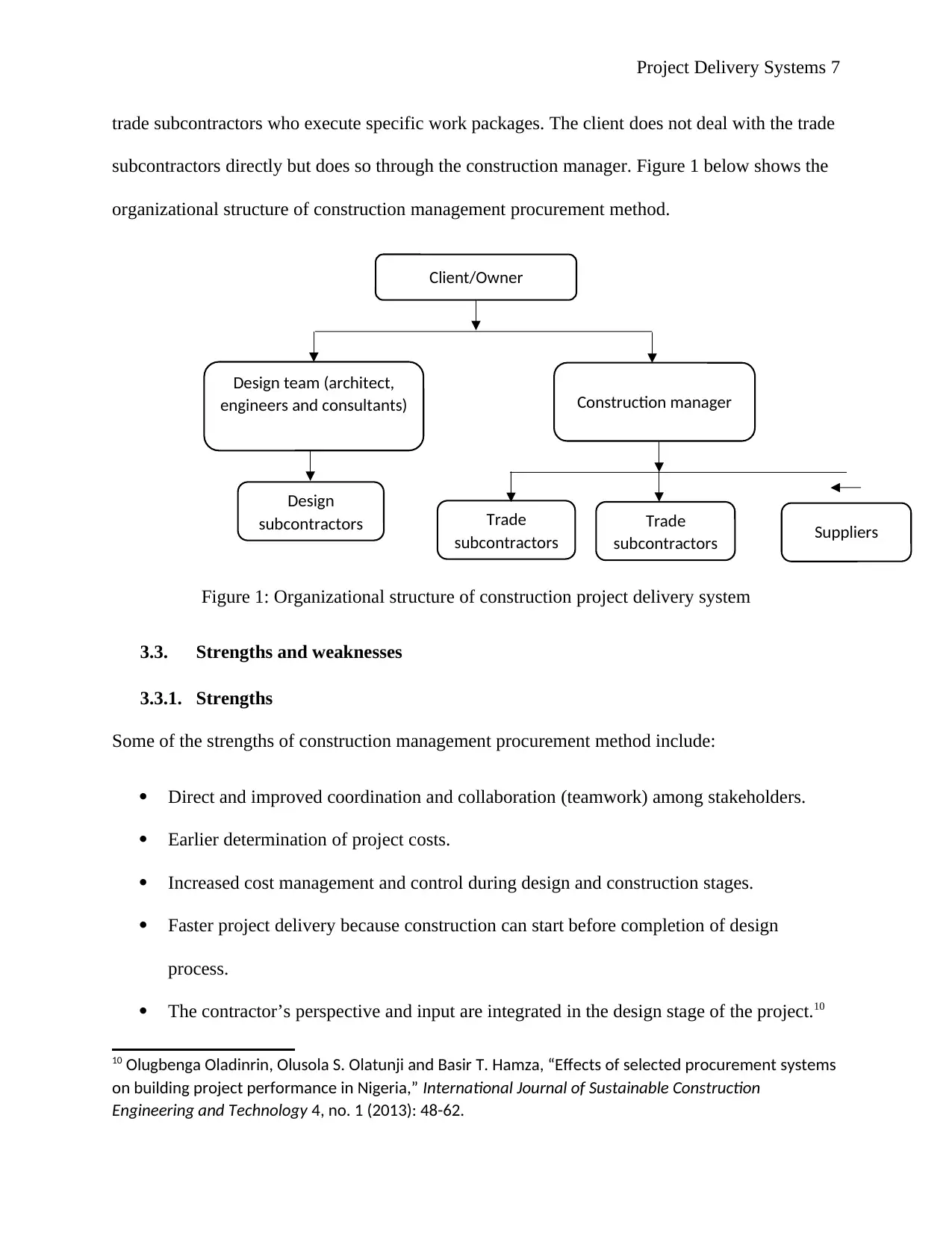
Project Delivery Systems 7
trade subcontractors who execute specific work packages. The client does not deal with the trade
subcontractors directly but does so through the construction manager. Figure 1 below shows the
organizational structure of construction management procurement method.
Figure 1: Organizational structure of construction project delivery system
3.3. Strengths and weaknesses
3.3.1. Strengths
Some of the strengths of construction management procurement method include:
Direct and improved coordination and collaboration (teamwork) among stakeholders.
Earlier determination of project costs.
Increased cost management and control during design and construction stages.
Faster project delivery because construction can start before completion of design
process.
The contractor’s perspective and input are integrated in the design stage of the project.10
10 Olugbenga Oladinrin, Olusola S. Olatunji and Basir T. Hamza, “Effects of selected procurement systems
on building project performance in Nigeria,” International Journal of Sustainable Construction
Engineering and Technology 4, no. 1 (2013): 48-62.
Client/Owner
Design team (architect,
engineers and consultants) Construction manager
Design
subcontractors Trade
subcontractors
Trade
subcontractors Suppliers
trade subcontractors who execute specific work packages. The client does not deal with the trade
subcontractors directly but does so through the construction manager. Figure 1 below shows the
organizational structure of construction management procurement method.
Figure 1: Organizational structure of construction project delivery system
3.3. Strengths and weaknesses
3.3.1. Strengths
Some of the strengths of construction management procurement method include:
Direct and improved coordination and collaboration (teamwork) among stakeholders.
Earlier determination of project costs.
Increased cost management and control during design and construction stages.
Faster project delivery because construction can start before completion of design
process.
The contractor’s perspective and input are integrated in the design stage of the project.10
10 Olugbenga Oladinrin, Olusola S. Olatunji and Basir T. Hamza, “Effects of selected procurement systems
on building project performance in Nigeria,” International Journal of Sustainable Construction
Engineering and Technology 4, no. 1 (2013): 48-62.
Client/Owner
Design team (architect,
engineers and consultants) Construction manager
Design
subcontractors Trade
subcontractors
Trade
subcontractors Suppliers
Paraphrase This Document
Need a fresh take? Get an instant paraphrase of this document with our AI Paraphraser

Project Delivery Systems 8
Design changes can be made at later stages of the project to meet the owner’s
requirements with minimal cost implications.
It is possible to predict the final project outcome during the planning phase.
Close supervision and total control of project quality.
High quality outcome because each work package is subcontracted to a specialist trade
subcontractor.
The design team, construction manager, trade subcontractors provide more professional
services focusing on meeting client needs.
Promotes creativity and implementation of cost reduction and control strategies.
It allows fast-tracking of the project.
Lowers project cost through competitive tendering of trade contractors
3.3.2. Weaknesses
Some of the strengths of construction management procurement method include:
Disputes between the design team and construction manager can lead to litigation,
increased costs and schedule delays.
Certainty of cost can only be determined after all packages of the project have been
prepared.
Not possible to estimate the total cost of the project at early stages.
The fee charged by the construction manager may not be the lowest that the client can get
in the market.
The construction manager may be reluctant to adopt cost reduction and faster delivery
initiatives if not remunerated as expected.
Design changes can be made at later stages of the project to meet the owner’s
requirements with minimal cost implications.
It is possible to predict the final project outcome during the planning phase.
Close supervision and total control of project quality.
High quality outcome because each work package is subcontracted to a specialist trade
subcontractor.
The design team, construction manager, trade subcontractors provide more professional
services focusing on meeting client needs.
Promotes creativity and implementation of cost reduction and control strategies.
It allows fast-tracking of the project.
Lowers project cost through competitive tendering of trade contractors
3.3.2. Weaknesses
Some of the strengths of construction management procurement method include:
Disputes between the design team and construction manager can lead to litigation,
increased costs and schedule delays.
Certainty of cost can only be determined after all packages of the project have been
prepared.
Not possible to estimate the total cost of the project at early stages.
The fee charged by the construction manager may not be the lowest that the client can get
in the market.
The construction manager may be reluctant to adopt cost reduction and faster delivery
initiatives if not remunerated as expected.

Project Delivery Systems 9
The success of the project largely depends on the construction manager’s performance
and commitment.
3.4. Weakness management strategies
Some of the strategies of managing the weaknesses of construction management method include:
Appointing a qualified construction manager.
Appointing the construction manager during the planning stage.
Determining the minimum cost certainty level as early as possible.
Clear definition and communication of responsibilities of every stakeholder.11
Offering the construction manager a reasonable fee, slightly above market rates.
Establishing appropriate change control processes.
Ensuring that specialist trade subcontractors are selected based on their performance and
capability.
Enhancing effective communication among stakeholders.
Adopting an open communication policy system where stakeholders can easily share
information and challenges encountered.
4. Strategies to ensure successful project delivery
Construction management method will ensure that the project is delivered on time and within
budget through different means. First, this method will allow overlapping of design and
construction phases. This reduces completion time. Second, the method will ensure that each
work package is subcontracted to specialist trade subcontractors who will be able to complete the
work more quickly and at a lower cost. Third, the method will enable the construction manager
11 Davis Langdon and Simon Rawlinson, “Procurement: construction management,” Building, 2018 accessed April 3,
2019, https://www.building.co.uk/data/procurement-construction-management/3072705.article#commentsJump
The success of the project largely depends on the construction manager’s performance
and commitment.
3.4. Weakness management strategies
Some of the strategies of managing the weaknesses of construction management method include:
Appointing a qualified construction manager.
Appointing the construction manager during the planning stage.
Determining the minimum cost certainty level as early as possible.
Clear definition and communication of responsibilities of every stakeholder.11
Offering the construction manager a reasonable fee, slightly above market rates.
Establishing appropriate change control processes.
Ensuring that specialist trade subcontractors are selected based on their performance and
capability.
Enhancing effective communication among stakeholders.
Adopting an open communication policy system where stakeholders can easily share
information and challenges encountered.
4. Strategies to ensure successful project delivery
Construction management method will ensure that the project is delivered on time and within
budget through different means. First, this method will allow overlapping of design and
construction phases. This reduces completion time. Second, the method will ensure that each
work package is subcontracted to specialist trade subcontractors who will be able to complete the
work more quickly and at a lower cost. Third, the method will enable the construction manager
11 Davis Langdon and Simon Rawlinson, “Procurement: construction management,” Building, 2018 accessed April 3,
2019, https://www.building.co.uk/data/procurement-construction-management/3072705.article#commentsJump
⊘ This is a preview!⊘
Do you want full access?
Subscribe today to unlock all pages.

Trusted by 1+ million students worldwide

Project Delivery Systems 10
to select trade contractors on competitive basis. This means that qualified trade contractors are
those with the capability to complete their respective work packages within the shortest time and
lowest cost possible. Fourth, the method allows for collaboration and coordination of
stakeholders involved in the project. This helps in avoiding and resolving disputes and conflicts
that could otherwise result to project delays and increased project costs. Fifth, the method will
encourage creativity and competition among trade subcontractors to see who completes the
assigned work more quickly, cost effectively and to the highest level of quality standards needed.
Last but not least, this method will see the owner appoint a qualified and experienced
construction manager who is able to coordinate all design and construction activities
accordingly, and closely monitor and control project cost and quality.
To achieve project success using construction management procurement method, the
client has to ensure that he appoints a qualified and experienced design team and construction
manager. These parties are the major determinants of the success of the project. The construction
manager should be appointed and involved in the project from the very early stages – planning
stage, so that his perspectives and inputs can be integrated in the design of the project. The client
has to ensure that there are adequate financial resources from the start of the project and
throughout the project. The client, together with the construction manager, should develop a
system of rewarding trade contractors who complete their work packages earlier and below or
within the budget. Last but not least, the construct manager should ensure that modern
construction technologies and systems are used throughout the project. This include building
information modelling (BIM), lean construction, prefabrication, green building (such as
renewable energy) and automated building management systems. These technologies and
systems will help to reduce project completion time, lifecycle costs and environmental impacts.
to select trade contractors on competitive basis. This means that qualified trade contractors are
those with the capability to complete their respective work packages within the shortest time and
lowest cost possible. Fourth, the method allows for collaboration and coordination of
stakeholders involved in the project. This helps in avoiding and resolving disputes and conflicts
that could otherwise result to project delays and increased project costs. Fifth, the method will
encourage creativity and competition among trade subcontractors to see who completes the
assigned work more quickly, cost effectively and to the highest level of quality standards needed.
Last but not least, this method will see the owner appoint a qualified and experienced
construction manager who is able to coordinate all design and construction activities
accordingly, and closely monitor and control project cost and quality.
To achieve project success using construction management procurement method, the
client has to ensure that he appoints a qualified and experienced design team and construction
manager. These parties are the major determinants of the success of the project. The construction
manager should be appointed and involved in the project from the very early stages – planning
stage, so that his perspectives and inputs can be integrated in the design of the project. The client
has to ensure that there are adequate financial resources from the start of the project and
throughout the project. The client, together with the construction manager, should develop a
system of rewarding trade contractors who complete their work packages earlier and below or
within the budget. Last but not least, the construct manager should ensure that modern
construction technologies and systems are used throughout the project. This include building
information modelling (BIM), lean construction, prefabrication, green building (such as
renewable energy) and automated building management systems. These technologies and
systems will help to reduce project completion time, lifecycle costs and environmental impacts.
Paraphrase This Document
Need a fresh take? Get an instant paraphrase of this document with our AI Paraphraser
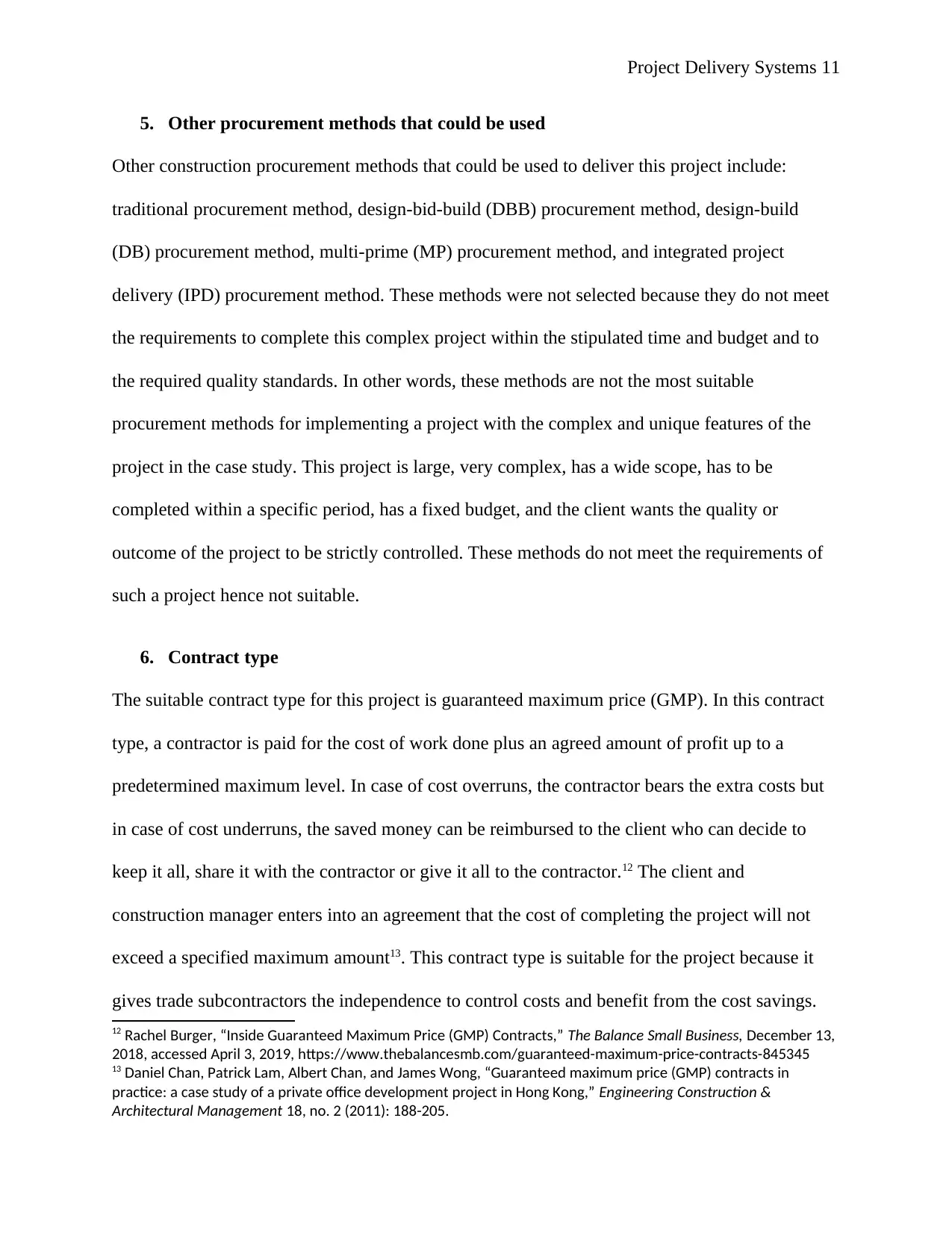
Project Delivery Systems 11
5. Other procurement methods that could be used
Other construction procurement methods that could be used to deliver this project include:
traditional procurement method, design-bid-build (DBB) procurement method, design-build
(DB) procurement method, multi-prime (MP) procurement method, and integrated project
delivery (IPD) procurement method. These methods were not selected because they do not meet
the requirements to complete this complex project within the stipulated time and budget and to
the required quality standards. In other words, these methods are not the most suitable
procurement methods for implementing a project with the complex and unique features of the
project in the case study. This project is large, very complex, has a wide scope, has to be
completed within a specific period, has a fixed budget, and the client wants the quality or
outcome of the project to be strictly controlled. These methods do not meet the requirements of
such a project hence not suitable.
6. Contract type
The suitable contract type for this project is guaranteed maximum price (GMP). In this contract
type, a contractor is paid for the cost of work done plus an agreed amount of profit up to a
predetermined maximum level. In case of cost overruns, the contractor bears the extra costs but
in case of cost underruns, the saved money can be reimbursed to the client who can decide to
keep it all, share it with the contractor or give it all to the contractor.12 The client and
construction manager enters into an agreement that the cost of completing the project will not
exceed a specified maximum amount13. This contract type is suitable for the project because it
gives trade subcontractors the independence to control costs and benefit from the cost savings.
12 Rachel Burger, “Inside Guaranteed Maximum Price (GMP) Contracts,” The Balance Small Business, December 13,
2018, accessed April 3, 2019, https://www.thebalancesmb.com/guaranteed-maximum-price-contracts-845345
13 Daniel Chan, Patrick Lam, Albert Chan, and James Wong, “Guaranteed maximum price (GMP) contracts in
practice: a case study of a private office development project in Hong Kong,” Engineering Construction &
Architectural Management 18, no. 2 (2011): 188-205.
5. Other procurement methods that could be used
Other construction procurement methods that could be used to deliver this project include:
traditional procurement method, design-bid-build (DBB) procurement method, design-build
(DB) procurement method, multi-prime (MP) procurement method, and integrated project
delivery (IPD) procurement method. These methods were not selected because they do not meet
the requirements to complete this complex project within the stipulated time and budget and to
the required quality standards. In other words, these methods are not the most suitable
procurement methods for implementing a project with the complex and unique features of the
project in the case study. This project is large, very complex, has a wide scope, has to be
completed within a specific period, has a fixed budget, and the client wants the quality or
outcome of the project to be strictly controlled. These methods do not meet the requirements of
such a project hence not suitable.
6. Contract type
The suitable contract type for this project is guaranteed maximum price (GMP). In this contract
type, a contractor is paid for the cost of work done plus an agreed amount of profit up to a
predetermined maximum level. In case of cost overruns, the contractor bears the extra costs but
in case of cost underruns, the saved money can be reimbursed to the client who can decide to
keep it all, share it with the contractor or give it all to the contractor.12 The client and
construction manager enters into an agreement that the cost of completing the project will not
exceed a specified maximum amount13. This contract type is suitable for the project because it
gives trade subcontractors the independence to control costs and benefit from the cost savings.
12 Rachel Burger, “Inside Guaranteed Maximum Price (GMP) Contracts,” The Balance Small Business, December 13,
2018, accessed April 3, 2019, https://www.thebalancesmb.com/guaranteed-maximum-price-contracts-845345
13 Daniel Chan, Patrick Lam, Albert Chan, and James Wong, “Guaranteed maximum price (GMP) contracts in
practice: a case study of a private office development project in Hong Kong,” Engineering Construction &
Architectural Management 18, no. 2 (2011): 188-205.
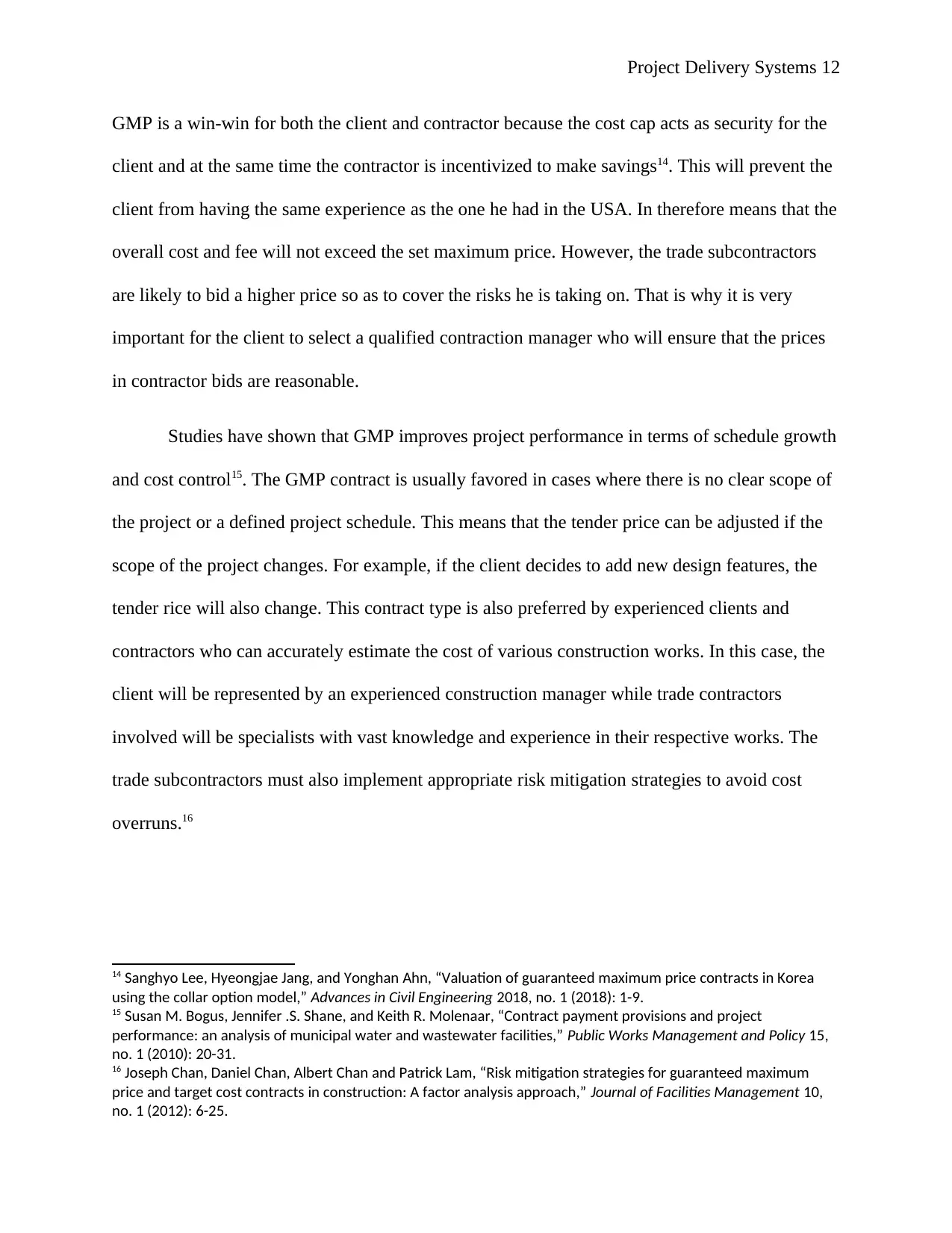
Project Delivery Systems 12
GMP is a win-win for both the client and contractor because the cost cap acts as security for the
client and at the same time the contractor is incentivized to make savings14. This will prevent the
client from having the same experience as the one he had in the USA. In therefore means that the
overall cost and fee will not exceed the set maximum price. However, the trade subcontractors
are likely to bid a higher price so as to cover the risks he is taking on. That is why it is very
important for the client to select a qualified contraction manager who will ensure that the prices
in contractor bids are reasonable.
Studies have shown that GMP improves project performance in terms of schedule growth
and cost control15. The GMP contract is usually favored in cases where there is no clear scope of
the project or a defined project schedule. This means that the tender price can be adjusted if the
scope of the project changes. For example, if the client decides to add new design features, the
tender rice will also change. This contract type is also preferred by experienced clients and
contractors who can accurately estimate the cost of various construction works. In this case, the
client will be represented by an experienced construction manager while trade contractors
involved will be specialists with vast knowledge and experience in their respective works. The
trade subcontractors must also implement appropriate risk mitigation strategies to avoid cost
overruns.16
14 Sanghyo Lee, Hyeongjae Jang, and Yonghan Ahn, “Valuation of guaranteed maximum price contracts in Korea
using the collar option model,” Advances in Civil Engineering 2018, no. 1 (2018): 1-9.
15 Susan M. Bogus, Jennifer .S. Shane, and Keith R. Molenaar, “Contract payment provisions and project
performance: an analysis of municipal water and wastewater facilities,” Public Works Management and Policy 15,
no. 1 (2010): 20-31.
16 Joseph Chan, Daniel Chan, Albert Chan and Patrick Lam, “Risk mitigation strategies for guaranteed maximum
price and target cost contracts in construction: A factor analysis approach,” Journal of Facilities Management 10,
no. 1 (2012): 6-25.
GMP is a win-win for both the client and contractor because the cost cap acts as security for the
client and at the same time the contractor is incentivized to make savings14. This will prevent the
client from having the same experience as the one he had in the USA. In therefore means that the
overall cost and fee will not exceed the set maximum price. However, the trade subcontractors
are likely to bid a higher price so as to cover the risks he is taking on. That is why it is very
important for the client to select a qualified contraction manager who will ensure that the prices
in contractor bids are reasonable.
Studies have shown that GMP improves project performance in terms of schedule growth
and cost control15. The GMP contract is usually favored in cases where there is no clear scope of
the project or a defined project schedule. This means that the tender price can be adjusted if the
scope of the project changes. For example, if the client decides to add new design features, the
tender rice will also change. This contract type is also preferred by experienced clients and
contractors who can accurately estimate the cost of various construction works. In this case, the
client will be represented by an experienced construction manager while trade contractors
involved will be specialists with vast knowledge and experience in their respective works. The
trade subcontractors must also implement appropriate risk mitigation strategies to avoid cost
overruns.16
14 Sanghyo Lee, Hyeongjae Jang, and Yonghan Ahn, “Valuation of guaranteed maximum price contracts in Korea
using the collar option model,” Advances in Civil Engineering 2018, no. 1 (2018): 1-9.
15 Susan M. Bogus, Jennifer .S. Shane, and Keith R. Molenaar, “Contract payment provisions and project
performance: an analysis of municipal water and wastewater facilities,” Public Works Management and Policy 15,
no. 1 (2010): 20-31.
16 Joseph Chan, Daniel Chan, Albert Chan and Patrick Lam, “Risk mitigation strategies for guaranteed maximum
price and target cost contracts in construction: A factor analysis approach,” Journal of Facilities Management 10,
no. 1 (2012): 6-25.
⊘ This is a preview!⊘
Do you want full access?
Subscribe today to unlock all pages.

Trusted by 1+ million students worldwide
1 out of 19
Related Documents
Your All-in-One AI-Powered Toolkit for Academic Success.
+13062052269
info@desklib.com
Available 24*7 on WhatsApp / Email
![[object Object]](/_next/static/media/star-bottom.7253800d.svg)
Unlock your academic potential
Copyright © 2020–2025 A2Z Services. All Rights Reserved. Developed and managed by ZUCOL.





